
|
 |  Εκτύπωση Εκτύπωση
 |  | Kourion |
ANNOUNCEMENT
The Department of Antiquities, Deputy Ministry of Culture, announces to the public that the sanitary facilities of the archaeological site of Kourion will be closed, due to maintenance works, for a period of four (4) weeks from the 8th April 2024. Biological toilets will be available.
We apologize for the inconvenience. |
The hill of Kourion, on which the acropolis of the ancient city-kingdom developed, occupies a dominant position on the coast 4 km southwest of the village of Episkopi in the Lemesos district. The earliest evidence of settlement in the broader area of Kourion dates to the Neolithic period (5500-3900 B.C.), whilst the most ancient remains in the general area of the ancient city are associated with settlements and tombs of the Middle and Late Bronze Age. According to tradition Kourion was founded by Argives in the 12th century B.C. This foundation myth may be associated with the decline of the Mycenean world and the consequent influx of Aegean populations to the East.
Systematic excavations were undertaken in 1933 by the Pennsylvania University Museum, and continued, with a break during the war years, until 1954. In 1974-1979 the American Mission of the Dumbarton Oaks Center for Byzantine Studies carried out excavations in the Early Christian Basilica of Kourion. From 1975 until 1998 the Department of Antiquities of Cyprus excavated the Agora, the House of Gladiators, the Small Basilica next to the Stadium and the Coastal Basilica. The Department of Antiquities also focuses on the management, preservation and promotion of the archaeological site of Kourion, through the application of concrete strategies aiming at securing its sustainability and development.
The most important monuments at the site are:
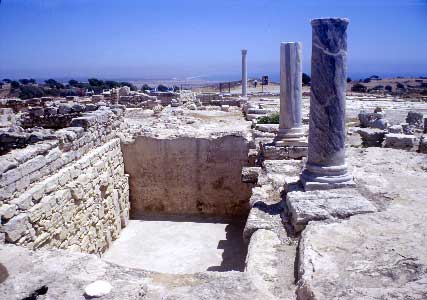
Kourion:The Agora
The Agora: The Roman Agora in its present state is a structure of the early 3rd century A.D. with additions dating to the Early Christian period. It was built on the remains of an earlier public building, which was in use from the end of the 4th century to the end of the Hellenistic period. The Agora is surrounded on both sides by porticos with marble columns. An impressive public bath and a Nymphaeum, which supplied the city with water, occupy the northwest side of the Agora.
The House of Achilles: Only part of the building, which is situated at the northwestern end of Kourion near the old Lemesos-Pafos road, is preserved today. It is a Roman villa of the first half of the 4th century A.D. with a central peristyle court. Several rooms are decorated with mosaic floors. The most interesting floor depicts the popular story of the revealing of Achilles' true identity by Odysseus in the court of the king Lycomedes at Skyros. The excavators suggest that this was a civic reception centre for distinguished visitors.
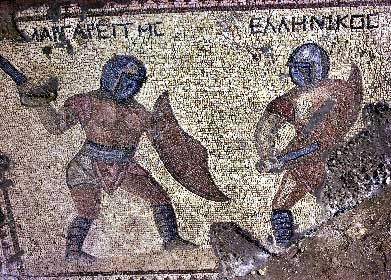
Kourion: Mosaic from the House of the Gladiators
The House of the Gladiators: This Roman house, which dates to the second half of the 3rd century A.D., is situated a few meters to the east of the House of Achilles. It has a central courtyard with corridors on all four sides and rooms opening onto them. Among the mosaics, which decorate the east and south wings of the courtyard, the most important are those in the east wing depicting a Gladiator combat scene which is rare in Cyprus.
The Theatre: It was originally built in the 2nd century B.C. but what is preserved today dates to the Roman period with 2nd and 3rd century A.D. additions and restorations. In the curved auditorium the spectators’ seating area accommodates around 3500 people. The stage only preserves its foundations but it originally rose to the full height of the auditorium. Today the theatre is used for cultural events.
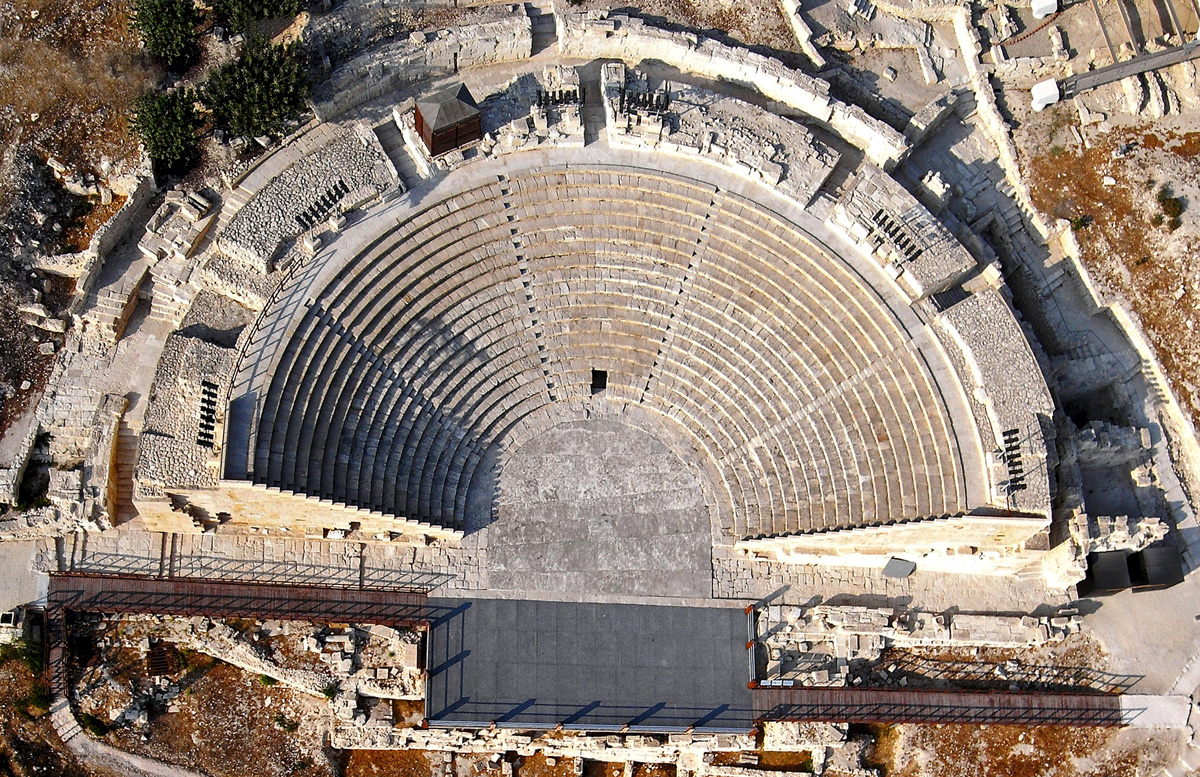 Kourion: Theatre
Kourion: Theatre
The Baths and the Complex of Eustolios: The complex of Eustolios is situated in an imposing position at the southeast end of Kourion. The building was the residence of a rich inhabitant of the town and dates to the end of the 4th century-early 5th century A.D.. It consists of many rooms surrounding two courtyards and a bath establishment. The group of mosaic pavements, which cover the majority of the building, are of particular interest. Through the inscriptions we know the name of the owner, a certain Eustolios as well as the fact that he was a Christian.
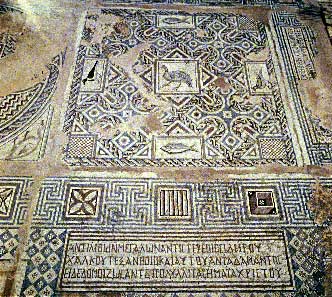
Kourion: Mosaic from the complex of Eustolios
The Early Christian Basilica: South of the Agora are the remains of the large complex of buildings belonging to the three-aisled basilica, the cathedral of Kourion. Originally built in the beginning of the 5th century A.D., it underwent architectural alterations and received new mosaic and opus sectile pavements in the 6th century. In the west, the basilica communicated with a narthex and a succession of buildings including the diakonikon, where the faithful deposited their offerings, and the house of the bishop of Kourion. To the north, the basilica extended to the atrium and the baptistery, which had the form of a small three-aisled basilica with a narthex. After the destruction of the basilica in the 7th century many pieces belonging to its mural marble sculpture were transferred and incorporated in the pavement of the newly-erected church of the neighbouring village of Episkopi.
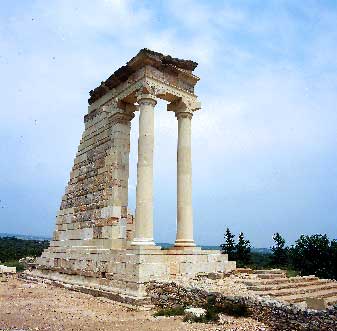
The Sanctuary of Apollo Hylates
The Sanctuary of Apollo Hylates
The sanctuary is located about 2,5 kilometres west of the ancient town of Kourion along the road which leads to Pafos. It was one of the main religious centres of ancient Cyprus, where Apollo was worshipped as god of the woodlands. It seems that the worship of Apollo on this site began as early as the 8th century B.C. and continued until the 4th century A.D. The site has undergone many extensions and alterations in different periods. The majority of the monuments as they can be seen today belong to the site's 1st century AD restorations. A wall from which one could enter the site via the Kourion Gate and the Pafos Gate surrounds the sanctuary. Originally the site consisted of: a temple, traces of which survive in the foundations of the present temple; a circular monument, which was probably destined for processions or dances around a grove of sacred trees; and a formalized Archaic Altar and Precinct. During the Roman period the site was extended with the addition of the South and North Buildings, which may have been used for the display of votives or the accommodation of visitors. Terracotta figurines and pottery that were accumulated in the Temple from the 5th century B.C. to the Roman period were buried in the Votive Pit. A long street running from south to north leads to the Temple of Apollo Hylates, which was built in the Late Classical or Early Hellenistic period on the ruins of the Archaic temple. In the 1st century A.D. the temple was rebuilt with a different architectural style. A small building south of the Precinct may have been a priest’s house. Along the external east side of the walls are the Palaestra where athletes once exercised and played games, and the Baths.
The Stadium: The ruins of the ancient stadium are preserved to the east of the sanctuary of Apollo. The stadium has a U-shaped plan and has seven rows of seats which would have accommodated around 6000 spectators. It was built in the 2nd century A.D. and was used until the end of the 5th century.
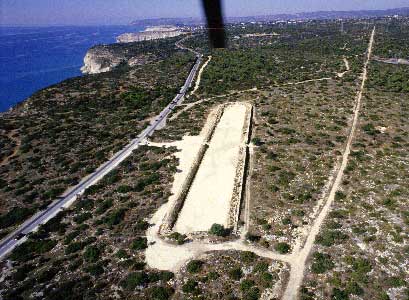 Kourion: the Stadium
Kourion: the Stadium
The Small Basilica: The three-aisled small basilica of Kourion, which dates to the 5th century A.D., is situated next to the stadium. The basilica had a narthex and an atrium with four porticos in the west. In the middle of the atrium there was a reservoir that was destroyed and replaced by a medieval limestone kiln. Adjoining the basilica to the north was a corridor and a chapel.
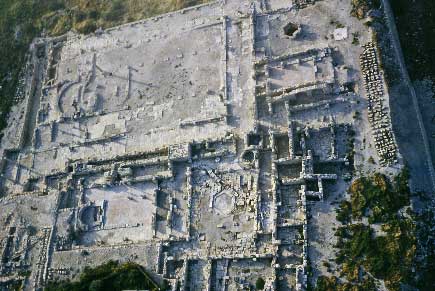
| District | Lemesos (Limassol) |
| Telephone | 25934250 |
Opening hours
for Public Holiday opening hours see home page | Winter hours (16/9 - 15/4 )
Monday - Sunday: 08.30 - 17.00
(last ticket issued at 16.30)
Summer hours (16/4 - 15/9)
Monday - Sunday: 8.30 - 19.30
(last ticket issued at 19.00)
Sanctuary of Apollo Hylates: Daily as above
|
| Admission | €4,50 |
| Accessibility | 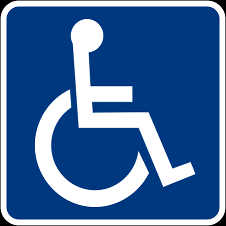
Almost all the site is wheelchair accessible: small bridges and passageways
(The site´s western part can be accessed via a special entrance that can be opened by the site´s guards)
Special Parking Space: available (marked)
Special rest rooms: available (marked)
Access to free wi-fi at Visitor's Centre |
|  |
|
|